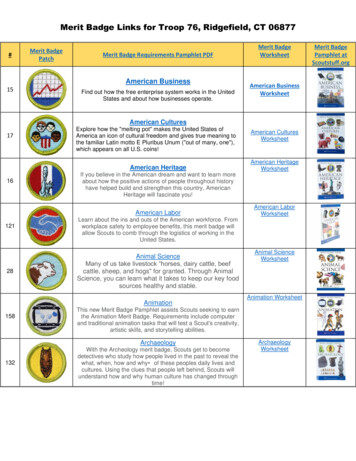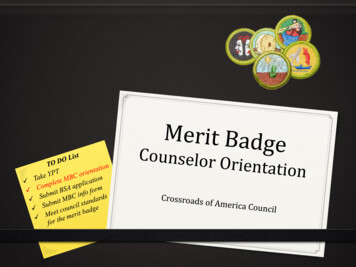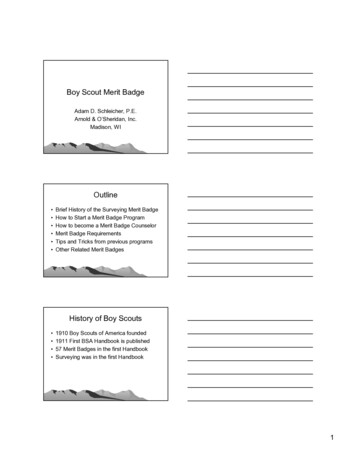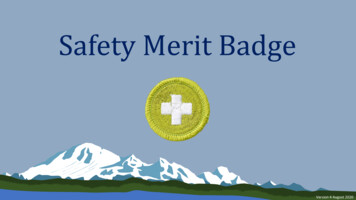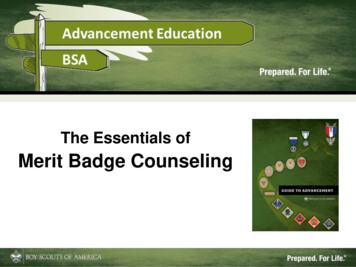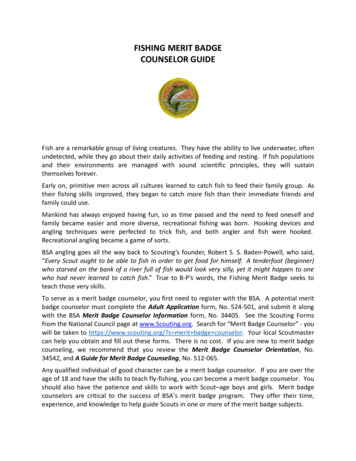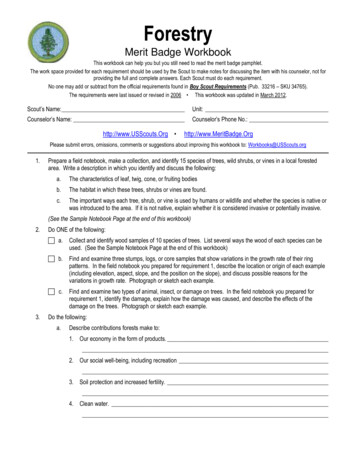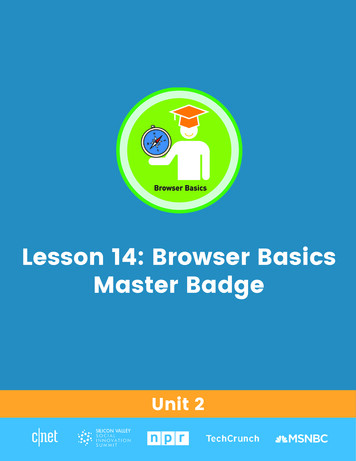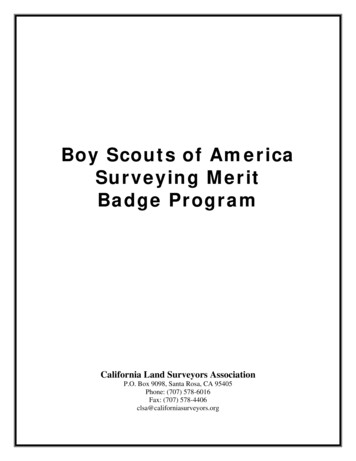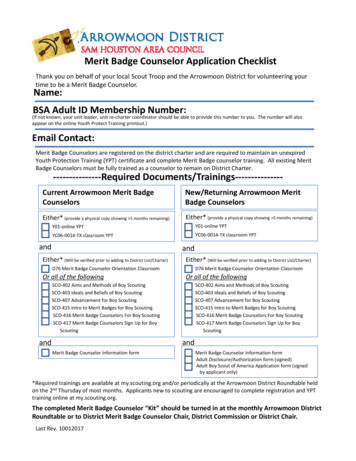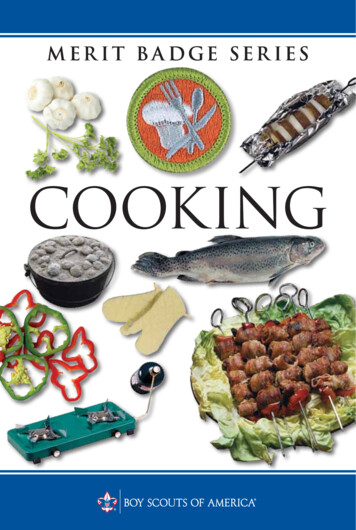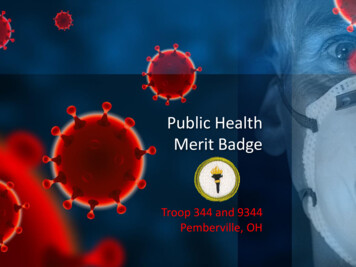
Transcription
Public HealthMerit BadgeTroop 344 and 9344Pemberville, OH
Public HealthRequirements1.Do the following:a.Explain what public health is. Explain how Escherichia coli (E.coli), tetanus, HIV/AIDS, malaria, salmonellosis, and Lymedisease are contracted.b. Choose any FOUR of the following diseases or conditions, andexplain how each one is contracted and possibly prevented:gonorrhea, West Nile virus, Zika, botulism, influenza, syphilis,hepatitis, emphysema, meningitis, herpes, lead poisoning.c.For each disease or condition in requirement 1b, explain:1.2.3.4.The type or form of the malady (viral, bacterial, environmental,toxin)Any possible vectors for transmissionWays to help prevent exposure or the spread of infectionAvailable treatments
Public HealthRequirements2.Do the following:a.Explain the meaning of immunization.b. Name eight diseases against which a young child should beimmunized, two diseases against which everyone should be reimmunized periodically, and one immunization everyoneshould receive annually.c.Using the list of diseases and conditions in requirement 1b,discuss with your counselor those which currently have noimmunization available.
Public HealthRequirements3.4.Discuss the importance of safe drinking water in terms of thespread of disease. Then, demonstrate two ways for making watersafe to drink that can be used while at camp. In yourdemonstration, explain how dishes and utensils should be washed,dried, and kept sanitary at home and in camp.Explain what a vector is and how insects and rodents can becontrolled in your home, in your community, and at camp. Tell whythis is important. In your discussion, explain which vectors can beeasily controlled by individuals and which ones require long-term,collective action.
Public HealthRequirements5.With your parent's and counselor's approval, do ONE of thefollowing:a.Visit a municipal wastewater treatment facility OR a solidwaste management operation in your community.1. Describe how the facility safely treats and disposes ofsewage or solid waste.2. Discuss your visit and what you learned with your counselor.3. Describe how sewage and solid waste should be disposed ofunder wilderness camping conditions.
Public HealthRequirements5.With your parent's and counselor's approval, do ONE of thefollowing:b. Visit a food service facility, such as a restaurant or schoolcafeteria.1. Observe food preparation, handling, and storage. Learn howthe facility keeps food from becoming contaminated.2. Find out what conditions allow micro-organisms to multiplyin food, what can be done to help prevent them fromgrowing and spreading, and how to kill them.3. Discuss the importance of using a thermometer to checkfood temperatures.4. Discuss your visit and what you learned with your counselor.
Public HealthRequirements6.Do the following:a.Describe the health dangers from air, water, and noisepollution.b. Describe health dangers from tobacco use and alcohol anddrug abuse.c.Describe the health dangers from abusing illegal andprescription drugs.7. With your parent's and counselor's approval, do ONE of thefollowing:a.Visit your city, county, or state public health agency.b. Familiarize yourself with your city, county, or state healthagency's website.
Public HealthRequirements8.After completing either 7a or 7b, do the following:a.b.c.9.Compare the four leading causes of mortality (death) in your communityfor any of the past five years with the four leading causes of disease inyour community. Explain how the public health agency you visited istrying to reduce the mortality and morbidity rates of these leading causesof illness and death.Explain the role of your health agency as it relates to the outbreak ofdiseases.Discuss the kinds of public assistance the agency is able to provide in caseof disasters such as floods, storms, tornadoes, earthquakes, and otheracts of destruction. Your discussion can include the cleanup necessaryafter the disaster.Pick a profession in the public health sector that interests you. Find outthe education, training, and experience required to work in thisprofession. Discuss what you learn with your counselor.
Requirement 11.Do the following:a.Explain what public health is. Explain howEscherichia coli (E. coli), tetanus, HIV/AIDS, malaria,salmonellosis, and Lyme disease are contracted.b.Choose any FOUR of the following diseases orconditions, and explain how each one is contractedand possibly prevented: gonorrhea, West Nile virus,Zika, botulism, influenza, syphilis, hepatitis,emphysema, meningitis, herpes, lead poisoning.c.For each disease or condition in requirement 1b,explain:1.2.3.4.The type or form of the malady (viral, bacterial,environmental, toxin)Any possible vectors for transmissionWays to help prevent exposure or the spread ofinfectionAvailable treatments
Requirement 1a What is Public Health?– Public health is the science of protecting and improvingthe health of people and their communities. This work isachieved by promoting healthy lifestyles, researchingdisease and injury prevention, and detecting, preventingand responding to infectious diseases.
Requirement 1aKnowing how diseases can be spread is key to prevention.–––––Aerosol/dropletsDirect contactContaminated waterContaminated foodVectors (Organisms which carry and transmit an infectiouspathogen into another living organism.)
Requirement 1a Escherichia coli (E. coli)– E. coli is one of the most commonbacteria found in human andanimal digestive systems– It’s benefits to us include theproduction of vitamin K (helpsblood clotting) and by preventingother dangerous germs to grow inour guts.
Requirement 1a Escherichia coli (E. coli)– However, some strains can producetoxins that can make us sick or causedeath.– Occasionally during food preparationour food becomes contaminated with“bad” E. coli.– If the food is not cooked properly, weingest these germs and they causeillness.– They can also be acquired by swallowingcontaminated swimming water.
Requirement 1aPathogenic E. coliType or FormBacteriaMethod ofTransmissionor VectorsEating food contaminated with animal feces.No animal vectors.Methods ofPreventionWash your hands thoroughly before preparing food!!Wash vegetable produce before serving.Keep meats away from foods that won’t be cooked.Cook ground or tenderized meats to an internaltemperature of 160oF.Available TreatmentsSupportive care, including hydration.Antibiotics and anti-diarrheal drugs should not beused as they increase the risk of complications.
Requirement 1a Tetanus– Also known as lockjaw, is caused bya toxin produced by the bacteriaClostridium tetani.– C. tetani is a common environmentalbacteria found in soil, especiallycurrent or former farm lands.– Characteristic symptoms includesever muscle pain and stiffness,difficulty swallowing, muscle spasms(strong enough to break bones).
Requirement 1a Tetanus– Commonly associated with rustynails. It is not the rust that causestetanus, but the dirt and lowoxygen environment of therust that provides a place forthe germs to hide.– 10% to 20% of those infected die.
Requirement 1aTetanusType or FormBacteriaMethod ofTransmissionor VectorsPuncture wounds from dirty objects.No animal vectors.Methods ofPreventionVaccination available.Booster shots every 10 years for adults.If you suffer a deep puncture wound, applyappropriate first-aid and follow up with a doctor.Wear shoes!AvailableTreatmentsTetanus antitoxin.Antibiotics.
Requirement 1a HIV/AIDS– Caused by the HumanImmunodeficiency Virus.– The virus replicates itself insidethe human white blood cellsresponsible for controlling ourimmune systems.– When the virus destroysenough cells over time, ourimmune system fails.– Patients become verysusceptible to opportunisticinfections.
Requirement 1a
Requirement 1aMain Symptoms of Acute HIV Infection
Requirement 1aHIV/AIDSType or FormVirusMethod ofTransmissionor VectorsDirect contact with human bodily fluids.No animal vectors.Methods of PreventionSafe sex practices or abstinence.Don’t use illicit drugs.Substance abusers should take advantage of needleexchange programs.Health care workers need to wear personal protectionequipment.Testing of blood/organs before transfusion/transplants.Available TreatmentsNo vaccine, no cure.Antiviral drugs can slow progress of disease.Treatment of opportunistic infections.
Requirement 1a Malaria is a mosquito-borne disease caused by a parasite. People with malaria often experience fever, chills, and flu-likeillness. Left untreated, they may develop severe complications anddie. In 2018 an estimated 228 million cases of malaria occurredworldwide and 405,000 people died, mostly children in theAfrican Region. About 2,000 cases of malaria are diagnosed in the UnitedStates each year. The vast majority of cases in the United States are in travelersand immigrants returning from countries where malariatransmission occurs.
Requirement 1aMalariaType or FormParasitic protozoan (Plasmodim sp.)Method ofTransmissionor VectorsMosquitoesMethods ofPreventionControl mosquitoes.Use insect repellant with DEET.Sleeping under mosquito netting.Antimalarial medicines can also be used toprevent malaria.AvailableTreatmentsAntimalarial medicines.
Requirement 1a Salmonellosis– Caused by the bacteria Salmonella.– Infection occurs by ingesting foodproducts contaminated with Salmonella– Symptoms occur 12 to 72 hours afterconsuming contaminated food andincludes vomiting and diarrhea.– In children, elderly, and persons withweakened immune systems, severity ofthe infection can cause death.– Contamination usually occurs during foodhandling and preparation.– The bacteria are common on reptiles,amphibians, rodents, and birds (chicken).
Requirement 1aSalmonellaType or FormBacteriaMethod ofTransmissionor VectorsEating foods contaminated with feces from aninfected animal.No animal vectors.Methods ofPreventionWash your hands thoroughly before preparing food!!Wash vegetable produce before serving.Keep meats away from foods that won’t be cooked.Cook ground or tenderized meats to an internaltemperature of 160oF.Available TreatmentsSupportive care, including hydration.Antibiotics and anti-diarrheal drugs should not beused as they increase the risk of complications.
Requirement 1a Lyme Disease– Caused by bacteria transmitted bythe deer tick.– Symptoms can include chills andfever, headache, fatigue, stiffneck, muscle and/or joint pain,and swollen glands.– A bull’s eye rash is typical in manycases.
Requirement 1aLyme DiseaseType or FormBacteriaMethod ofTransmissionor VectorsDeer Tick (Ixodes scapularis)Also called Blacklegged TickMethods ofPreventionIn tick areas: Wear light colored clothing. Use insect repellents with DEET. Check your body for ticks and remove within 24hours.Know how to properly remove a tick if you are bitten.Available TreatmentsAntibiotics
Requirement1aNymph ticks are actuallythe most likely to transmitLyme disease or anothertick-borne infection tohumans than ticks at otherstages. Less than twomillimeters in size, nymphscan bite people and remainvirtually undetected.
Requirement 1a
Requirement 11.Do the following:a.Explain what public health is. Explain howEscherichia coli (E. coli), tetanus, HIV/AIDS, malaria,salmonellosis, and Lyme disease are contracted.b.Choose any FOUR of the following diseases orconditions, and explain how each one is contractedand possibly prevented: gonorrhea, West Nile virus,Zika, botulism, influenza, syphilis, hepatitis,emphysema, meningitis, herpes, lead poisoning.c.For each disease or condition in requirement 1b,explain:1.2.3.4.The type or form of the malady (viral, bacterial,environmental, toxin)Any possible vectors for transmissionWays to help prevent exposure or the spread ofinfectionAvailable treatments
Requirement 1bGonorrheaType or FormBacteriaMethod ofTransmissionor VectorsSexuallytransmitteddisease (STD).No animal vectors.Methods ofPreventionAbstinenceSafe sex practicesAvailable TreatmentsAntibiotics
Requirement 1bWest Nile VirusType or FormVirusMethod ofTransmissionor VectorsMosquitoes transmitvirus from birds.Methods ofPreventionEliminate stagnantwater sources.Use insect repellentAvailableTreatmentsNo diseasetreatment.Supportive care.Symptoms and signs of West Nilevirus include fever, headache, bodyaches, skin rash, and swollen lymphnodes. Most cases of West Nile virusinfection are mild and go unreported.
Requirement 1bZikaType or FormVirusMethod ofTransmissionor VectorsMosquitoesMethods ofPreventionEliminate stagnantwater sources.Use insectrepellentAvailable TreatmentsNo diseasetreatment.Supportive care.In most cases, there are nosymptoms. In a few cases, Zika cantrigger paralysis (Guillain-BarréSyndrome). In pregnant women, itmay cause subsequent birth defects.When present, symptoms are mildand last less than a week. Theyinclude fever, rash, joint pain, andred eyes.
Requirement 1bBotulismType or FormBacteria toxinMethod of Transmissionor VectorsFood borne botulism: Humans come intocontact with botulism by eating improperlycanned or preserved foods that contain thebotulinum toxin.Wound botulism : Humans come intocontact with botulism when a wound isinfected with bacteria.No animal vectors.Methods of PreventionSafe food handling.Proper wound care.Available TreatmentsAntitoxinSupportive careAntibiotics
Requirement 1bInfluenzaType or FormVirusMethod ofTransmissionor VectorsPerson-to-personAerosol/droplet.No animal vectors.Methods ofPreventionHand washing.Social distancing.Available TreatmentsSupportive care.Antiviral therapies.Every year in the United States, on average: 5% to 20% of the population gets the flu. More than 200,000 people are hospitalized from flu-related complications. About 36,000 people die from flu-related causes.
Requirement 1bCorona VirusType or FormVirusMethod ofTransmissionor VectorsPerson-to-person.Aerosol/droplet.No animal vectors.Methods ofPreventionHand washing.Social distancing.Available TreatmentsSupportive care.The coronavirus (COVID-19), causes severe acute respiratory problems. The World Health Organizationdeclared the outbreak a pandemic on March 11, 2020. As of May 19, 2020, more than 4.86 millioncases of COVID-19 have been reported in more than 188 countries and territories, resulting in morethan 321,000 deaths. More than 1.66 million people have recovered from the virus.
Requirement 1bSyphilisType or FormBacteriaMethod ofTransmissionor VectorsSexually transmitteddisease (STD).No animal vectors.Methods ofPreventionAbstinence.Safe sex practices.Available TreatmentsAntibiotics.
Requirement 1bHepatitisType or FormVirusesMethod ofTransmissionor VectorsBlood borne pathogen.Foodborne illness.No animal vectors.Methods of PreventionBlood and body fluidprecautions.Proper foodhandling/hygiene.Vaccination.No animal vectors.Available TreatmentsAntiviral therapies.Supportive care.Hepatitis refers to aninflammatory condition ofthe liver. It's commonlycaused by a viral infection,
Requirement 1bEmphysemaType or FormEnvironmentalMethod ofTransmissionor VectorsChronic exposure totoxic chemicals suchas long-term smoking.No animal vectors.Methods of PreventionDon’t smoke.Avoid second-handsmoke.Available TreatmentsNo cure.Supportive/comfortcare until death.Lung transplants.
Requirement 1bMeningitisType or FormBacteria or virusMethod ofTransmissionor VectorsPerson-to-person.No animal vectors.Methods able TreatmentsBacterial – Antibiotics.Viral – Usually selflimiting*.Supportive care.*Self-limiting: They last a while and then goaway as your body fights them.
Requirement 1bHerpesType or FormVirusMethod ofTransmissionor VectorsSexually transmitteddisease (STD).Maternal to infant.No animal vectors.Methods ofPreventionAbstinence.Safe sex.Available TreatmentsNo cure.Antivirals to controloutbreaks.
Requirement 1bLead PoisoningType or FormEnvironmentalMethod ofTransmissionor VectorsEnvironmental exposure(usually ingestion byinfants/toddlers).No animal vectors.Methods ofPreventionEnvironmental monitoring.Abatement (Eliminate andremove lead based paint).Identification of “at risk”persons.Available TreatmentsChelation therapyLead Paint
Requirement 22.Do the following:a.Explain the meaning of immunization.b. Name eight diseases against which a young childshould be immunized, two diseases againstwhich everyone should be re-immunizedperiodically, and one immunization everyoneshould receive annually.c.Using the list of diseases and conditions inrequirement 1b, discuss with your counselorthose which currently have no immunizationavailable.
Requirement 2a Immunization is theprocess whereby a personis made immune orresistant to an infectiousdisease, typically by theadministration of avaccine. Vaccines stimulate thebody's own immunesystem to protect theperson against subsequentinfection or disease.
Requirement 22.Do the following:a.Explain the meaning of immunization.b. Name eight diseases against which a young childshould be immunized, two diseases againstwhich everyone should be re-immunizedperiodically, and one immunization everyoneshould receive annually.c.Using the list of diseases and conditions inrequirement 1b, discuss with your counselorthose which currently have no immunizationavailable.
Requirement 2bRecommended Immunization Schedule 2020
Requirement 2b
Requirement 22.Do the following:a.Explain the meaning of immunization.b. Name eight diseases against which a young childshould be immunized, two diseases againstwhich everyone should be re-immunizedperiodically, and one immunization everyoneshould receive annually.c.Using the list of diseases and conditions inrequirement 1b, discuss with your counselorthose which currently have no immunizationavailable.
Requirement 2c Diseases for which there is currently no vaccine.––––––––GonorrheaWest Nile VirusZikaBotulismSyphilisEmphysemaHerpesLead Poisoning
Requirement 33.Discuss the importance of safe drinking water interms of the spread of disease. Then, demonstratetwo ways for making water safe to drink that can beused while at camp. In your demonstration, explainhow dishes and utensils should be washed, dried,and kept sanitary at home and in camp.
Requirement 3 Contaminated water can transmit diseasessuch as cholera, dysentery, typhoid, andpolio, and is estimated to cause 485,000diarrheal deaths in the world each year. Over the last 100 years, manyimprovements in the health, success, andlifespan of the U.S. population can belinked to improvements in water quality. Water treatment and disinfection was oneof the most important public healthachievements in the U.S. of the 20thcentury and have helped ensure access tohealthy and safe water for millions ofAmericans.
Requirement 3
Requirement 3 The water in lakes, rivers, and springs maylook crystal clear but often contains variousbacteria that can cause illness. Three purification methods:– Filters: Simply pump water from the sourcewith a water filter into a container. The filtermechanically removes protozoa and bacteria.– Chemical tablets: Water purification tablets,such as Potable Aqua, are a second option.They employ chemicals, usually iodine, to killharmful bacteria.– Boiling: Bringing water to a rolling boil is athird option.
Requirement 3Washing Dishes While Camping Prewash: Is for getting the waste off ofthe dishes.Hot Water Wash: Using as little soap aspossible, the dishes are washed. Thecleanest dishes go first, the dirtiestdishes go last.Hot Water Rinse: Rinse dishes in hotwater.Sanitizing Soak: dip dishes in a chlorineand water rinse to kill bacteria. Use 1tablespoon of bleach to 1 gallon ofwater for your rinse. Allow utensils toremain for 45 seconds in the rinse.The utensils should be air dried andthen covered or put away once dry.
Requirement 3How NOT to wash dishes while camping!!
Requirement 3Washing Dishes at Home Step One: Scrape food off surfaces before washing. Step Two: Wash the dishes in hot, soapy water. Be sure to use cleandishcloths each day and don’t use sponges! They tend to harborgerms. Step Three: Rinse dishes very thoroughly in clean, hot water. Youwant all the soap removed because soap that makes its way into yourchlorine bleach solution in Step 4 stops the bleach from sanitizing. Step Four: Sanitize the dishes with a chlorine bleach solution. Soakdishes for at least 45 seconds in a sanitizing solution made up of 1tablespoon of unscented chlorine bleach 1 gallon of cool water. Step Five: Allow dishes to air dry. Don’t dry with a cloth or towel; thiscan spread germs.
Requirement 44.Explain what a vector is and how insects and rodentscan be controlled in your home, in your community,and at camp. Tell why this is important. In yourdiscussion, explain which vectors can be easilycontrolled by individuals and which ones requirelong-term, collective action.
Requirement 4 A disease vector is an organism that does not cause a disease, buttransmits an infection by conveying pathogens from one host toanother, serving as a route of transmission.
Requirement 4Vector control focuses on utilizing preventive methods tocontrol or eliminate vector populations. Commonpreventive measures are: Habitat and environmental control– Removing or reducing areas where vectors can easily breedcan help limit their growth. Both individuals and communities can undertake stagnantwater removal, destruction of old tires and cans which serveas mosquito breeding environment. Both individuals and communities can reduce the presenceof garbage to reduce the incidence of flies and rodents actingas vectors to spread diseases. Both individuals and communities can reduce the presenceof human/animal (pet) feces to reduce the incidence of fliesacting as vectors to spread diseases.
Requirement 4Vector control focuses on utilizing preventive methods tocontrol or eliminate vector populations. Commonpreventive measures are: Reducing contact– Limiting exposure to insects or animals that are knowndisease vectors can reduce the likelihood of contact withvectors reducing infection risks significantly. The individual can use screens on homes or tents andwear protective clothing when outside, to reduce thelikelihood of contact with insect vectors. Eliminate entry points that rodents can use to enter thehome.
Requirement 4Vector control focuses on utilizing preventive methods tocontrol or eliminate vector populations. Commonpreventive measures are: Chemical control– Larvicides can be used in mosquito breeding zones throughcommunity programs.– Insecticides can be applied both around the home and community.– Individuals using insect repellents can reduce insect and tick bitesand thus infection.– Both individuals and communities can use rodenticides (rat poison)to control mice and rats. Biological control– The use of natural vector predators by government agencies canhelp control vector populations. Using fish that eat mosquito larvae,.
Requirement 55.With your parent's and counselor's approval, do ONE ofthe following:a.Visit a municipal wastewater treatment facility OR asolid-waste management operation in yourcommunity.1.2.3.b.Describe how the facility safely treats and disposes ofsewage or solid waste.Discuss your visit and what you learned with yourcounselor.Describe how sewage and solid waste should be disposedof under wilderness camping conditions.Visit a food service facility, such as a restaurant orschool cafeteria.1.2.3.4.Observe food preparation, handling, and storage. Learnhow the facility keeps food from becoming contaminated.Find out what conditions allow micro-organisms tomultiply in food, what can be done to help prevent themfrom growing and spreading, and how to kill them.Discuss the importance of using a thermometer to checkfood temperatures.Discuss your visit and what you learned with yourcounselor.
Requirement 5a1Take a virtual tour of a Wastewater Treatment Plant.
Requirement 5a1Take a virtual tour of a Solid Waste Management Facility.
Requirement 55.With your parent's and counselor's approval, do ONE ofthe following:a.Visit a municipal wastewater treatment facility OR asolid-waste management operation in yourcommunity.1.2.3.b.Describe how the facility safely treats and disposes ofsewage or solid waste.Discuss your visit and what you learned with yourcounselor.Describe how sewage and solid waste should be disposedof under wilderness camping conditions.Visit a food service facility, such as a restaurant orschool cafeteria.1.2.3.4.Observe food preparation, handling, and storage. Learnhow the facility keeps food from becoming contaminated.Find out what conditions allow micro-organisms tomultiply in food, what can be done to help prevent themfrom growing and spreading, and how to kill them.Discuss the importance of using a thermometer to checkfood temperatures.Discuss your visit and what you learned with yourcounselor.
Requirement 5a3How sewage and solid waste should be disposed of underwilderness camping conditions. Human Waste– Cat holes are the most widely accepted method of wastedisposal.– Locate cat holes at least 200 feet (about 70 adult paces)from water, trails and camp.– Select an inconspicuous site where other people will beunlikely to walk or camp.– With a small garden trowel, dig a hole 6-8 inches deep and4-6 inches in diameter.– The cat hole should be covered and disguised with naturalmaterials when finished.
Requirement 5a3How sewage and solid waste should be disposed of underwilderness camping conditions. Other Forms of Waste– “Pack it in, Pack it out” is a familiar mantra to seasonedwildland visitors.– Any user of recreation lands has a responsibility to cleanup before he or she leaves.– Inspect your campsite and rest areas for trash or spilledfoods.– Pack out all trash and garbage in resealable plastic bagsand dispose of properly when off of the trail.
Requirement 55.With your parent's and counselor's approval, do ONE ofthe following:a.Visit a municipal wastewater treatment facility OR asolid-waste management operation in yourcommunity.1.2.3.b.Describe how the facility safely treats and disposes ofsewage or solid waste.Discuss your visit and what you learned with yourcounselor.Describe how sewage and solid waste should be disposedof under wilderness camping conditions.Visit a food service facility, such as a restaurant orschool cafeteria.1.2.3.4.Observe food preparation, handling, and storage. Learnhow the facility keeps food from becoming contaminated.Find out what conditions allow micro-organisms tomultiply in food, what can be done to help prevent themfrom growing and spreading, and how to kill them.Discuss the importance of using a thermometer to checkfood temperatures.Discuss your visit and what you learned with yourcounselor.
Requirement 5b Take a virtual tour of an inspection of a Food ServiceFacility.
Requirement 66.Do the following:a.Describe the health dangers from air, water, andnoise pollution.b. Describe health dangers from tobacco use andalcohol and drug abuse.c.Describe the health dangers from abusing illegaland prescription drugs.
Requirement 6aHealth Dangers from Air Pollution Accelerated aging of the lungs. Loss of lung capacity anddecreased lung function. Development of diseases such asasthma, bronchitis, emphysema,and possibly cancer. Shortened life span.
Requirement 6aHealth Dangers from Water Pollution Infectious diseases can be spreadthrough contaminated water. Some of these water-bornediseases are Typhoid, Cholera,Paratyphoid Fever, Dysentery,Jaundice, Amoebiasis and Malaria.
Requirement 6aHealth Dangers from Water Pollution Chemicals in the water also have negative effects on our health.– Pesticides – can damage the nervous system and cause cancer becauseof the carbonates and organophosphates that they contain. Chloridescan cause reproductive and endocrinal damage.– Nitrates – are especially dangerous to babies that drink formula milk. Itrestricts the amount of oxygen in the brain and cause the “blue baby”syndrome.– Lead – can accumulate in the body and damage the central nervoussystem.– Arsenic – causes liver damage, skin cancer and vascular diseases– Fluorides - in excessive amounts can make your teeth yellow and causedamage to the spinal cord.– Petrochemicals – even with very low exposure, can cause cancer.
Requirement 6aHealth Dangers from Noise Pollution Loud sounds can damage sensitivestructures of the inner ear andcause hearing loss. Exposure to noise causes adversehealth effects like stress, anxiety,depression, high blood pressure,and heart disease.
Requirement 66.Do the following:a.Describe the health dangers from air, water, andnoise pollution.b. Describe health dangers from tobacco use andalcohol and drug abuse.c.Describe the health dangers from abusing illegaland prescription drugs.
Requirement 6bHealth Dangers from Tobacco Use. Smoking causes cancer, heart disease,stroke, lung diseases, diabetes, and chronicobstructive pulmonary disease (COPD),which includes emphysema and chronicbronchitis. Chewing tobacco use is a risk factor for thedevelopment of oral cancers and precancers.– Other health risks of chewing tobaccoinclude gum disease, tooth decay andtooth loss, and possible links to othercancers and cardiovascular disease.
Requirement 6bHealth Dangers from Alcohol Abuse. High blood pressure, heart disease, stroke, liver disease, anddigestive problems. Cancer of the breast, mouth, throat, esophagus, liver, andcolon. Weakening of the immune system, increasing the chances ofgetting sick. Learning and memory problems, including dementia andpoor school performance. Mental health problems, including depression and anxiety. Social problems, including lost productivity, family problems,and unemployment. Alcohol dependence, or al
a. Describe the health dangers from air, water, and noise pollution. b. Describe health dangers from tobacco use and alcohol and drug abuse. c. Describe the health dangers from abusing illegal and prescription drugs. 7. With your parent's and counselor's approval, do ONE of the following: a. Visit your city, county, or state public health .
